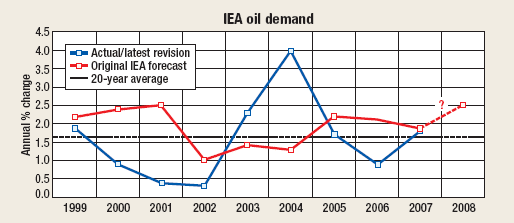Editorial comment
Oil demand and prices
Well, what happened was... Since 2004, China or India often pops up in the press and conversations about soaring oil demand. While it is of some interest to statisticians and forecasters-perhaps more so in recent years, while searching for an explanation of prices that fits-it doesn’t make sense to lay global demand at those countries’ feet alone. The last I heard, oil was a global commodity. And if a country or group of countries were to simply decrease supply to the world, well...that’s what OPEC does every day. And it’s able to do it with ease at the moment (claimed 66% compliance among members), since it doesn’t have to take that much supply off the table and, in any event, global surplus capacity is not as high as it once was (about 5 million barrels a day in 2002 vs. 1.5 million today), although it is slowly building. I think I’ll shoot myself if I hear another dinner or hallway conversation about how much global demand is soaring-it isn’t. And the agencies that try to forecast demand and prices have the impossible task of trying to predict the future, made more impossible when the present isn’t making much sense. They are faced with trying to explain why oil prices would rise in the face of growing inventories and growing excess capacity. Because this doesn’t make sense historically (since normally, rising inventories mean lower prices), both the EIA and the IEA have tended to over-predict demand, while under-predicting prices. Actually, in the face of high prices, mediocre demand makes sense. The truth is, predicting the future just a year in advance is very difficult. To be clear, I’m not complaining about the accuracy of IEA or EIA forecasts: I do not envy anyone who is in the prediction business. What people tend to do, habitually, is explain why the future wasn’t what they expected. In explaining the discrepancy, they invariably begin with the words, “Well, what happened was...” Their gift of hindsight explains why oil prices rose to a sharp peak in 1981, why they collapsed, why they collapsed again in 1986, why demand crashed in 1999-2002, why it soared in 2004, and fell again in 2005 and 2006, and so on. It seems to me a sort of intellectual cowardice that no governmental or even private oilfield agency can even mention the possibility of commodities market manipulation. It may not be going on, and there’s no “smoking gun” that would indicate it, but to never mention the possibility seems dishonest at best. It is, of course, a matter of court records that at least $2 billion was illegally manipulated in the California electricity debacle. And Gov. Schwarzenegger, among many others, thinks that it’s much more. And don’t forget about the Bunker Hunt silver market manipulation of the early 1980s (I remember, because I was playing the silver market at the time). There are hundreds of examples. The chance that manipulation is going on has increased, because changes in the law in the late 1990s have allowed a great many more traders to enter the commodities arena. And in 2000, other changes in the law have allowed a huge number of OTC trades to take place below the exchange radars, assuring that no oversight or watchdog authority will be looking. Surely that must increase the possibility of manipulation, but I seriously doubt that any evidence of such will be found. I suppose that it’s fear of being ridiculed as a conspiracy theorist that prevents anyone in authority from even mentioning the possibility. It’s akin to reporting the sighting of a UFO. Historically, markets tend to reverse when sentiment gets too high or too low. As a friend of mine says, “The party’s over when the stupid money comes in.” Looking at some of the unconventional resource plays, I have to wonder. They are obviously predicated on the belief that very high oil and gas prices are here to stay, as if a ledge was jumped in 2003, and we will never revisit that ledge again. And the historic 6-to-1 price ratio (based on energy) between oil and gas seems gone forever. Also, I’m confused when analysts and other folks are surprised to see an oil-related stock go flat or down. Apparently, they have been led to believe that oil and gas stocks respond well to perpetually high prices, when historically, they only respond to year-over-year and same-quarter comparisons. So, because the price of oil went down to a paltry $58 from $60 in the same quarter a year ago, they are shocked to see their stock respond poorly. The takeaway point of all of this is that the next time you hear that demand is soaring (or falling), and that’s why prices are high (or low), take it as “maybe, maybe not.” Whether the source is the press or governmental agencies, their initial prediction, given 18 months in advance of the next year-end, is only a little better than anyone’s guess.
It takes years for the data to be revised
and settle down. The situation reminds me of the foolishness that
so often accompanies global warming in private conversation, as well
as in the press. If it’s hot
one year, it must be due to global warming. And when there’s
a below-normal cold year-and I’m sure that this will happen-there
will be lots of people saying, “See, there is no global warming.” As
a casual look at the chart shows, if you average the annual variations,
you get a number close to the 20-year annual average growth (dashed
line) of about 1.6%. So much for soaring demand. The media and numerous
folks in our industry mistake the weather of these forecasts for the
oil demand climate.
|
||||||||





